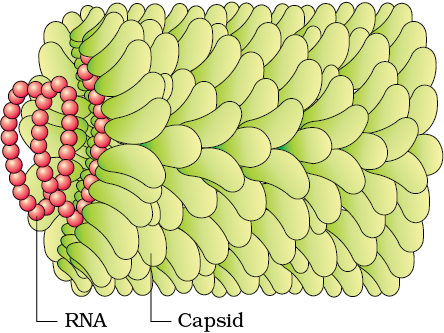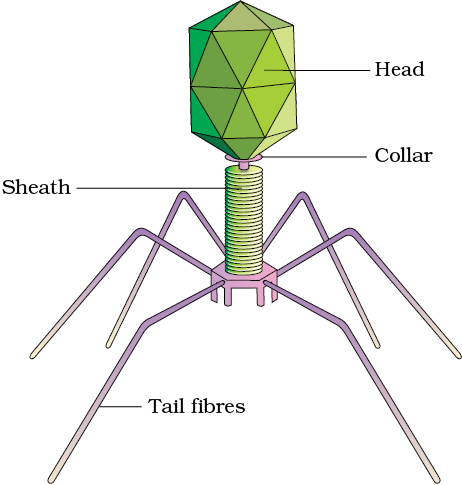In the five kingdom classification of Whittaker there is no mention of lichens and some acellular organisms like viruses, viroids and prions. These are briefly introduced here.
All of us who have suffered the ill effects of common cold or ‘flu’ know what effects viruses can have on us, even if we do not associate it with our condition. Viruses did not find a place in classification since they are not considered truly ‘living’, if we understand living as those organisms that have a cell structure. The viruses are non-cellular organisms that are characterised by having an inert crystalline structure outside the living cell. Once they infect a cell they take over the machinery of the host cell to replicate themselves, killing the host. Would you call viruses living or non-living?


The name virus that means venom or poisonous fluid was given by Dmitri Ivanowsky (1892) recognised certain microbes as causal organism of the mosaic disease of tobacco (Figure 2.6a). These were found to be smaller than bacteria because they passed through bacteria-proof filters. M.W. Beijerinek (1898) demonstrated that the extract of the infected plants of tobacco could cause infection in healthy plants and called the fluid as Contagium vivum fluidum (infectious living fluid). W.M. Stanley (1935) showed that viruses could be crystallised and crystals consist largely of proteins. They are inert outside their specific host cell. Viruses are obligate parasites.
In addition to proteins, viruses also contain genetic material, that could be either RNA or DNA. No virus contains both RNA and DNA. A virus is a nucleoprotein and the genetic material is infectious. In general, viruses that infect plants have single stranded RNA and viruses that infect animals have either single or double stranded RNA or double stranded DNA. Bacterial viruses or bacteriophages (viruses that infect the bacteria) are usually double stranded DNA viruses (Figure 2.6b). The protein coat called capsid made of small subunits called capsomeres, protects the nucleic acid. These capsomeres are arranged in helical or polyhedral geometric forms. Viruses cause diseases like mumps, small pox, herpes and influenza. AIDS in humans is also caused by a virus. In plants, the symptoms can be mosaic formation, leaf rolling and curling, yellowing and vein clearing, dwarfing and stunted growth.
Viroids : In 1971, T.O. Diener discovered a new infectious agent that was smaller than viruses and caused potato spindle tuber disease. It was found to be a free RNA; it lacked the protein coat that is found in viruses, hence the name viroid. The RNA of the viroid was of low molecular weight.
Prions : In modern medicine certain infectious neurological diseases were found to be transmitted by an agent consisting of abnormally folded protein. The agent was similar in size to viruses. These agents were called prions. The most notable diseases caused by prions are bovine spongiform encephalopathy (BSE) commonly called mad cow disease in cattle and its analogous variant Cr–Jacob disease (CJD) in humans.
Lichens : Lichens are symbiotic associations i.e. mutually useful associations, between algae and fungi. The algal component is known as phycobiont and fungal component as mycobiont, which are autotrophic and heterotrophic, respectively. Algae prepare food for fungi and fungi provide shelter and absorb mineral nutrients and water for its partner. So close is their association that if one saw a lichen in nature one would never imagine that they had two different organisms within them. Lichens are very good pollution indicators – they do not grow in polluted areas.
Biological classification of plants and animals was first proposed by Aristotle on the basis of simple morphological characters. Linnaeus later classified all living organisms into two kingdoms – Plantae and Animalia. Whittaker proposed an elaborate five kingdom classification – Monera, Protista, Fungi, Plantae and Animalia. The main criteria of the five kingdom classification were cell structure, body organisation, mode of nutrition and reproduction, and phylogenetic relationships.
In the five kingdom classification, bacteria are included in Kingdom Monera. Bacteria are cosmopolitan in distribution. These organisms show the most extensive metabolic diversity. Bacteria may be autotrophic or heterotrophic in their mode of nutrition. Kingdom Protista includes all single-celled eukaryotes such as Chrysophytes, Dinoflagellates, Euglenoids, Slime-moulds and Protozoans. Protists have defined nucleus and other membrane bound organelles. They reproduce both asexually and sexually. Members of Kingdom Fungi show a great diversity in structures and habitat. Most fungi are saprophytic in their mode of nutrition. They show asexual and sexual reproduction. Phycomycetes, Ascomycetes, Basidiomycetes and Deuteromycetes are the four classes under this kingdom. The plantae includes all eukaryotic chlorophyll-containing organisms. Algae, bryophytes, pteridophytes, gymnosperms and angiosperms are included in this group. The life cycle of plants exhibit alternation of generations – gametophytic and sporophytic generations. The heterotrophic eukaryotic, multicellular organisms lacking a cell wall are included in the Kingdom Animalia. The mode of nutrition of these organisms is holozoic. They reproduce mostly by the sexual mode. Some acellular organisms like viruses and viroids as well as the lichens are not included in the five kingdom system of classification.
1. Discuss how classification systems have undergone several changes over a period of time?
NEETprep Answer2. State two economically important uses of:
(a) heterotrophic bacteria
(b) archaebacteria
NEETprep Answer3. What is the nature of cell-walls in diatoms?
NEETprep Answer4. Find out what do the terms ‘algal bloom’ and ‘red-tides’ signify.
NEETprep Answer5. How are viroids different from viruses?
NEETprep Answer6. Describe briefly the four major groups of Protozoa.
NEETprep Answer7. Plants are autotrophic. Can you think of some plants that are partially heterotrophic?
NEETprep Answer